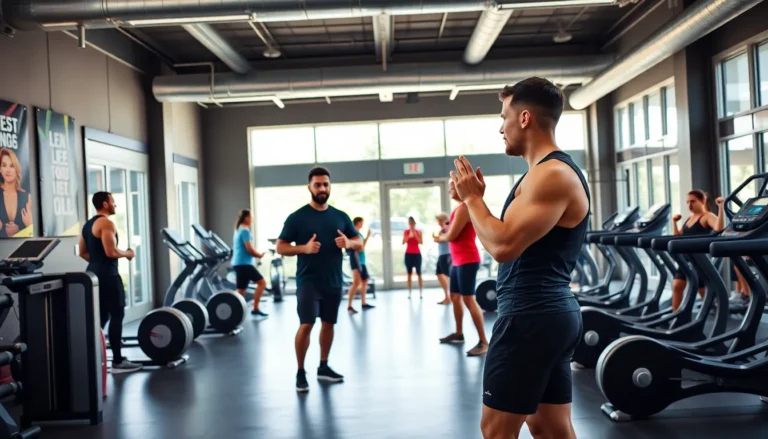Ever thought about sweating it out in a room full of friendly faces? Group fitness training might be your ticket to redefining your workout experience. Gone are the days of solitary treadmill sessions and uninspired lifting. With group classes, you get the motivation of a supportive community, plus the added bonus of high-energy music to drown out that nagging voice telling you to stop. Ready to explore how this dynamic training style can transform your fitness journey? Let’s immerse.
Table of Contents
ToggleWhat Is Group Fitness Training?

Group fitness training refers to structured workout sessions led by a qualified instructor, where multiple participants engage in exercises designed to improve their fitness. These classes can vary widely, from high-intensity interval training (HIIT) to calming yoga sessions. The environment is often uplifting and energetic, creating a unique experience that combines fitness with social interaction. Participants typically follow a set routine that covers strength, endurance, and flexibility, all within the same hour. Importantly, group fitness training promotes a sense of accountability: when individuals show up together, they’re more likely to stay committed to their fitness goals.
Benefits of Group Fitness Training
The perks of group fitness training are plentiful. One major benefit is the social aspect. When individuals work out together, they bond over shared struggles and triumphs, fostering friendships that go beyond the gym. This camaraderie creates a supportive environment that encourages each participant to push their limits.
Also, group classes provide a level of motivation that’s hard to replicate in solo workouts. Having an instructor to guide and motivate the group keeps everyone engaged and accountable. Another fantastic advantage is the variety offered in group classes. From dance-based workouts to strength training, the options are extensive, ensuring that boredom rarely creeps in. Finally, group fitness training also tends to be more cost-effective compared to personal training sessions, allowing individuals to enjoy the expertise of trainers at a fraction of the individual cost.
Types of Group Fitness Classes
The world of group fitness training is as diverse as the individuals who participate in it. Some popular types include:
1. Zumba
This dance-based workout incorporates various styles of music and dance, making it a fun way to burn calories.
2. Yoga
Focusing on flexibility, balance, and mindfulness, yoga classes cater to all levels, from beginners to advanced practitioners.
3. HIIT (High-Intensity Interval Training)
This fast-paced workout alternates between intense bursts of activity and short rest periods, proving highly effective for burning fat and building endurance.
4. Spin Classes
Participants get on stationary bikes for an exhilarating ride led by an instructor. The atmosphere is often electric, filled with pumping music and group motivation.
5. Pilates
This low-impact workout focuses on core strength and flexibility, ideal for those looking to enhance their posture and strength gently.
These classes not only help improve physical health but also provide an enjoyable way to socialize and relieve stress.
How to Choose the Right Group Fitness Class
Selecting the perfect group fitness class can feel overwhelming given the myriad options available. First, consider your fitness goals. Are you looking to build strength, improve flexibility, or boost endurance? Clarifying your objectives can help narrow down your choices.
Next, think about your preferred workout style. Do you enjoy high-energy classes, or do you prefer something more relaxing? Checking out the class schedule and watching a class can provide a glimpse into what to expect. It’s also wise to take note of the instructor’s qualifications. A skilled trainer can significantly enhance your experience and help prevent injuries. Finally, don’t hesitate to try out different classes. Most gyms offer trial versions or drop-in classes that allow individuals to find their perfect fit before committing.
Setting Goals in Group Fitness Training
Setting clear and achievable goals is essential in group fitness training. Without goals, it’s easy to drift through workouts without progress. Start by determining what you want to achieve in your fitness journey: Is it weight loss, strength gain, or improved endurance? Once defined, break these goals down into smaller, manageable milestones.
For instance, instead of aiming to lose 20 pounds in a few weeks, a more realistic goal could be to lose 1-2 pounds per week. This approach allows for gradual progress and prevents burnout.
Also, sharing these goals with the group can enhance accountability. When individuals voice their objectives, they create a sense of partnership and support, driving everyone to succeed together.
Tips for Success in Group Fitness Training
Succeeding in group fitness training requires more than just showing up. Here are several practical tips for individuals to maximize their experience:
- Stay Consistent: Attending classes regularly helps build both strength and familiarity.
- Communicate: Don’t hesitate to speak with instructors about any concerns or specific needs. They’re there to help.
- Be Open-Minded: Try different classes to discover new strengths and interests.
- Listen to Your Body: It’s essential to know your limits. Pushing too hard can lead to injury.
- Leave Insecurities at the Door: Everyone in the class is there to improve themselves, so focus on personal progress and celebrate achievements, no matter how small.





